Principle of Administration Report: Office Duties, Events, and More
VerifiedAdded on 2020/07/22
|11
|2875
|35
Report
AI Summary
This report on the principles of administration covers a wide range of topics essential for effective office management and leadership. It begins with an introduction to administration and then delves into specific tasks, including legal requirements for office duties, typical services provided by office families, and the establishment of office management procedures. The report further explores managing office resources, monitoring workflows, and defining support and welfare facilities. It also addresses legal obligations regarding health and safety, individual responsibilities, and accident and emergency procedures. The report examines meeting minutes, their purpose, legal implications, and accuracy, as well as different types of meetings and facilitation techniques. Additionally, it covers managing workloads through targets and budgets, allocating work to team members, quality management techniques, and identifying areas for improvement. Finally, the report discusses different types of events, information requirements, and event planning processes, concluding with a summary of key findings and references.
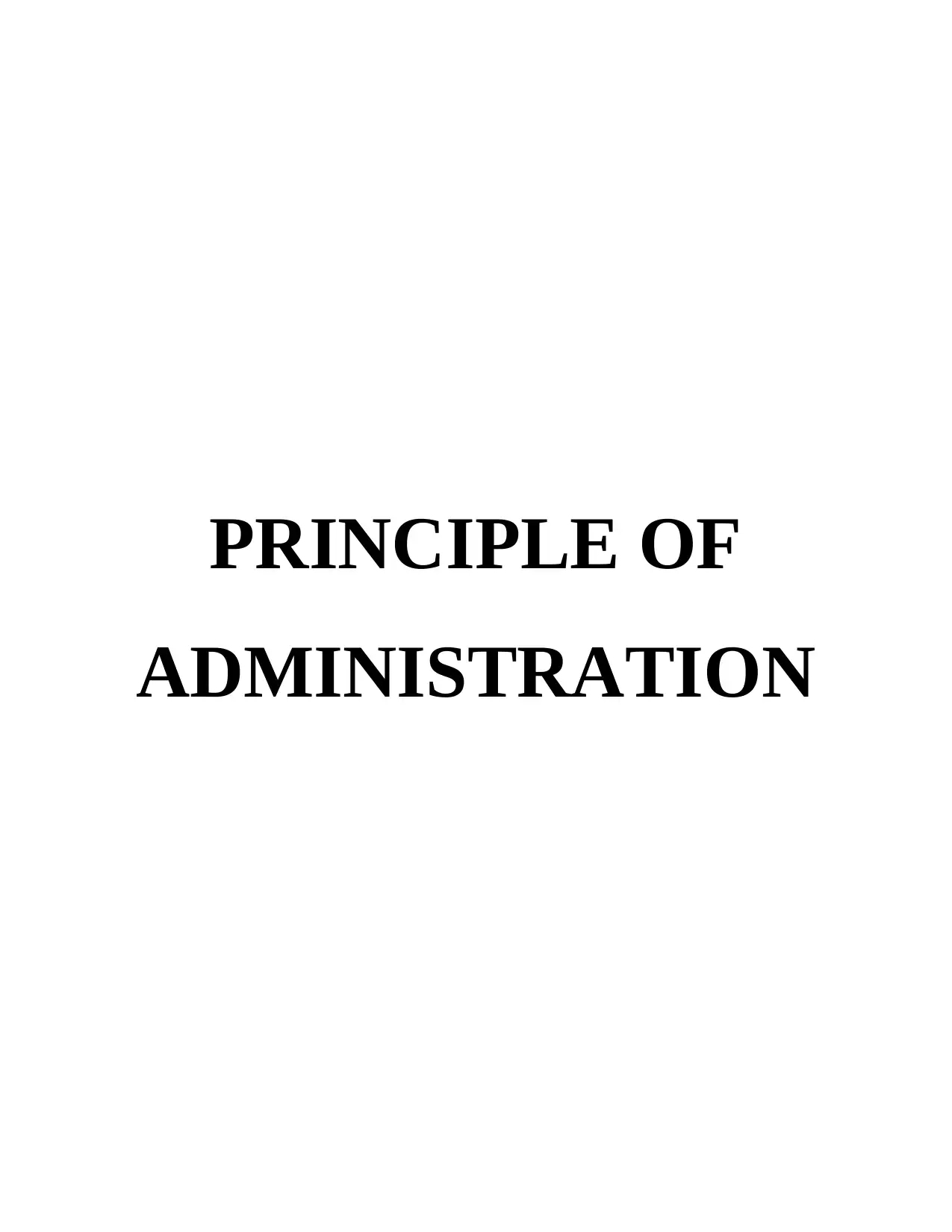
PRINCIPLE OF
ADMINISTRATION
ADMINISTRATION
Paraphrase This Document
Need a fresh take? Get an instant paraphrase of this document with our AI Paraphraser
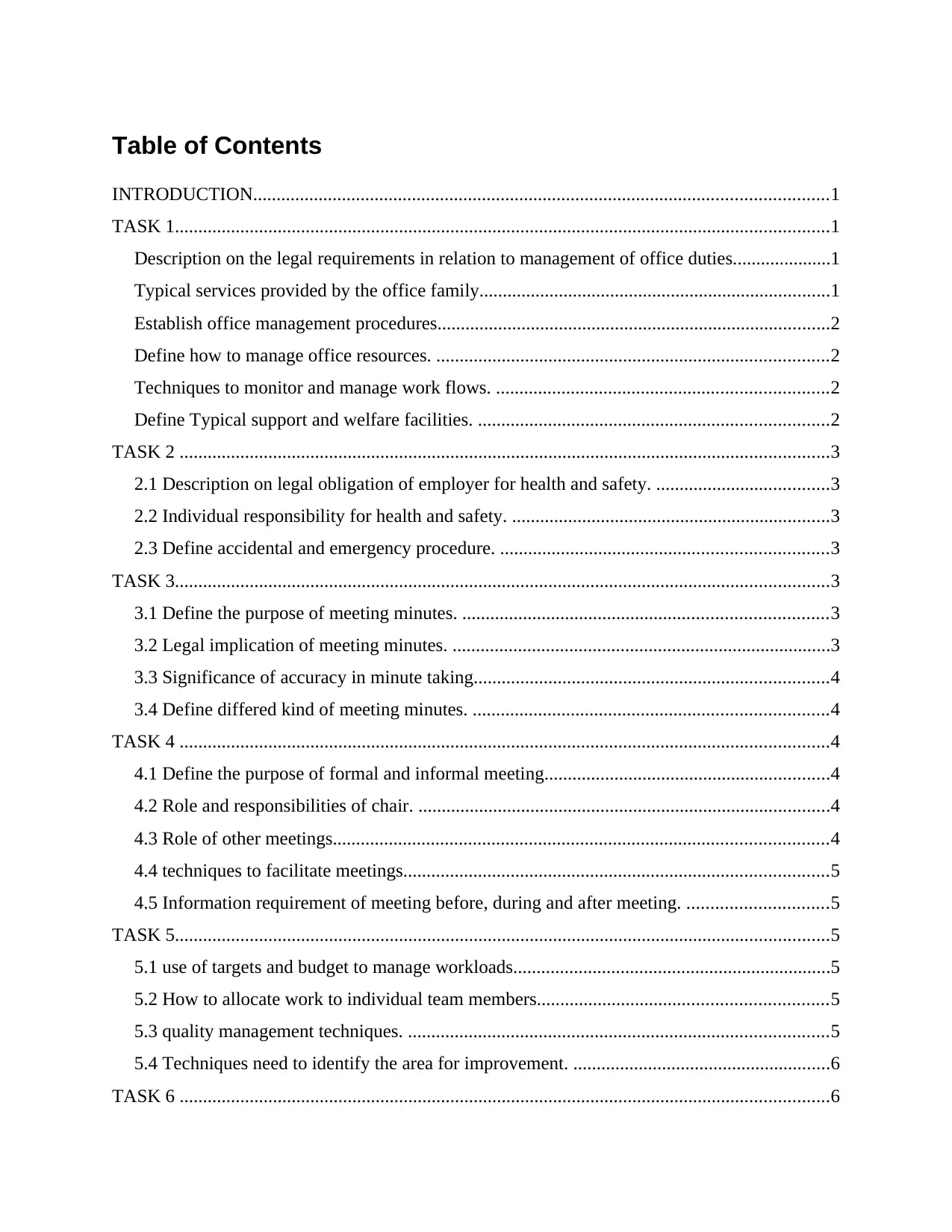
Table of Contents
INTRODUCTION...........................................................................................................................1
TASK 1............................................................................................................................................1
Description on the legal requirements in relation to management of office duties.....................1
Typical services provided by the office family...........................................................................1
Establish office management procedures....................................................................................2
Define how to manage office resources. ....................................................................................2
Techniques to monitor and manage work flows. .......................................................................2
Define Typical support and welfare facilities. ...........................................................................2
TASK 2 ...........................................................................................................................................3
2.1 Description on legal obligation of employer for health and safety. .....................................3
2.2 Individual responsibility for health and safety. ....................................................................3
2.3 Define accidental and emergency procedure. ......................................................................3
TASK 3............................................................................................................................................3
3.1 Define the purpose of meeting minutes. ..............................................................................3
3.2 Legal implication of meeting minutes. .................................................................................3
3.3 Significance of accuracy in minute taking............................................................................4
3.4 Define differed kind of meeting minutes. ............................................................................4
TASK 4 ...........................................................................................................................................4
4.1 Define the purpose of formal and informal meeting.............................................................4
4.2 Role and responsibilities of chair. ........................................................................................4
4.3 Role of other meetings..........................................................................................................4
4.4 techniques to facilitate meetings...........................................................................................5
4.5 Information requirement of meeting before, during and after meeting. ..............................5
TASK 5............................................................................................................................................5
5.1 use of targets and budget to manage workloads....................................................................5
5.2 How to allocate work to individual team members..............................................................5
5.3 quality management techniques. ..........................................................................................5
5.4 Techniques need to identify the area for improvement. .......................................................6
TASK 6 ...........................................................................................................................................6
INTRODUCTION...........................................................................................................................1
TASK 1............................................................................................................................................1
Description on the legal requirements in relation to management of office duties.....................1
Typical services provided by the office family...........................................................................1
Establish office management procedures....................................................................................2
Define how to manage office resources. ....................................................................................2
Techniques to monitor and manage work flows. .......................................................................2
Define Typical support and welfare facilities. ...........................................................................2
TASK 2 ...........................................................................................................................................3
2.1 Description on legal obligation of employer for health and safety. .....................................3
2.2 Individual responsibility for health and safety. ....................................................................3
2.3 Define accidental and emergency procedure. ......................................................................3
TASK 3............................................................................................................................................3
3.1 Define the purpose of meeting minutes. ..............................................................................3
3.2 Legal implication of meeting minutes. .................................................................................3
3.3 Significance of accuracy in minute taking............................................................................4
3.4 Define differed kind of meeting minutes. ............................................................................4
TASK 4 ...........................................................................................................................................4
4.1 Define the purpose of formal and informal meeting.............................................................4
4.2 Role and responsibilities of chair. ........................................................................................4
4.3 Role of other meetings..........................................................................................................4
4.4 techniques to facilitate meetings...........................................................................................5
4.5 Information requirement of meeting before, during and after meeting. ..............................5
TASK 5............................................................................................................................................5
5.1 use of targets and budget to manage workloads....................................................................5
5.2 How to allocate work to individual team members..............................................................5
5.3 quality management techniques. ..........................................................................................5
5.4 Techniques need to identify the area for improvement. .......................................................6
TASK 6 ...........................................................................................................................................6
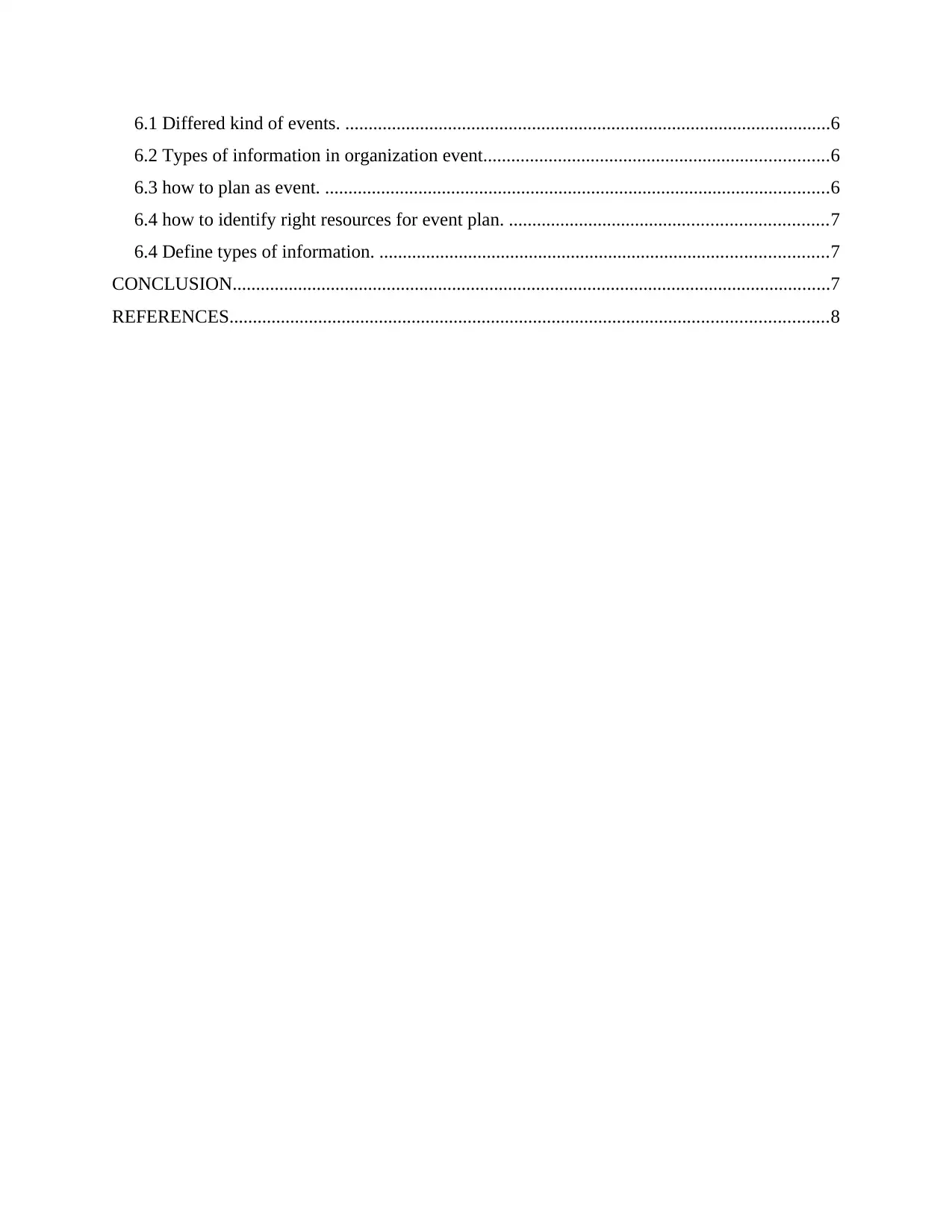
6.1 Differed kind of events. ........................................................................................................6
6.2 Types of information in organization event..........................................................................6
6.3 how to plan as event. ............................................................................................................6
6.4 how to identify right resources for event plan. ....................................................................7
6.4 Define types of information. ................................................................................................7
CONCLUSION................................................................................................................................7
REFERENCES................................................................................................................................8
6.2 Types of information in organization event..........................................................................6
6.3 how to plan as event. ............................................................................................................6
6.4 how to identify right resources for event plan. ....................................................................7
6.4 Define types of information. ................................................................................................7
CONCLUSION................................................................................................................................7
REFERENCES................................................................................................................................8
⊘ This is a preview!⊘
Do you want full access?
Subscribe today to unlock all pages.

Trusted by 1+ million students worldwide
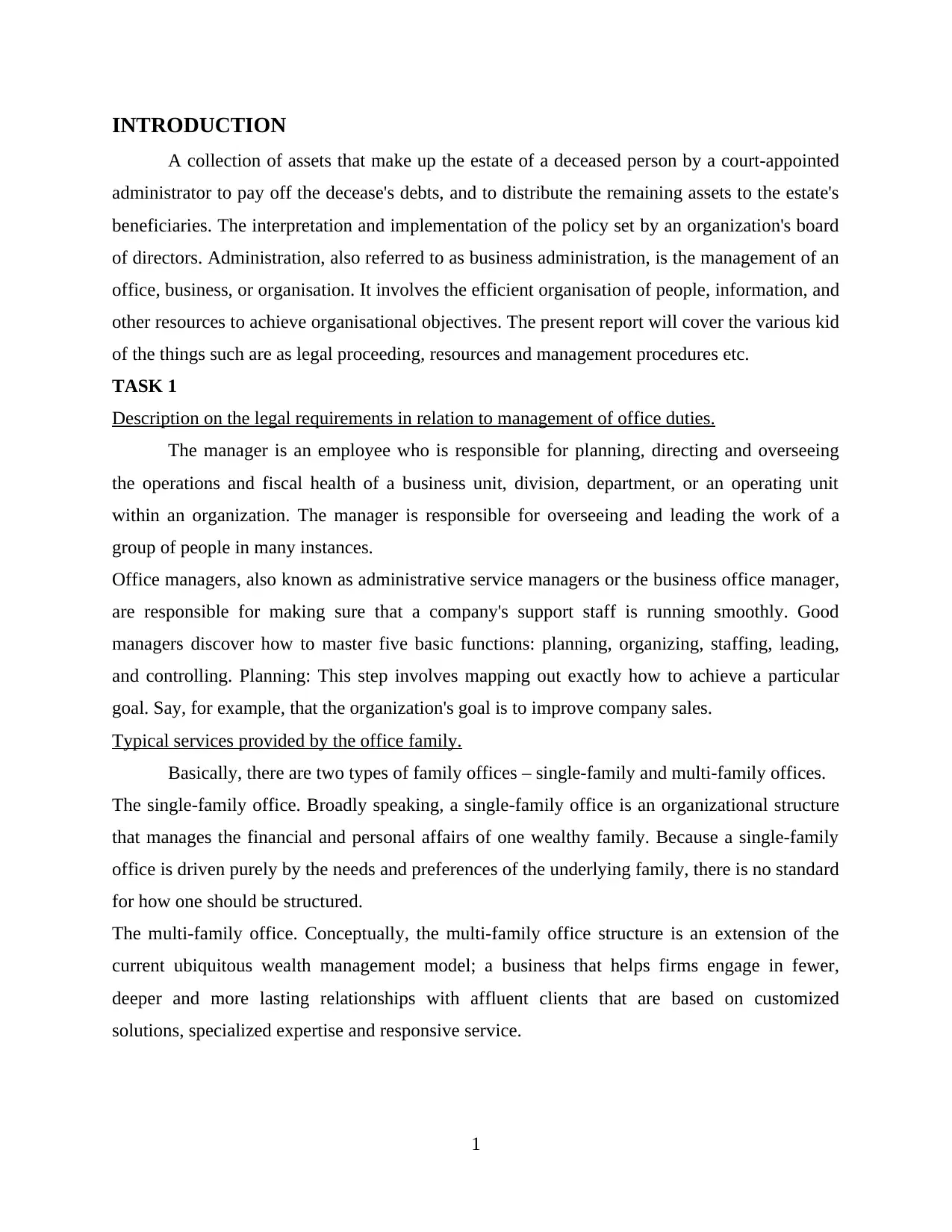
INTRODUCTION
A collection of assets that make up the estate of a deceased person by a court-appointed
administrator to pay off the decease's debts, and to distribute the remaining assets to the estate's
beneficiaries. The interpretation and implementation of the policy set by an organization's board
of directors. Administration, also referred to as business administration, is the management of an
office, business, or organisation. It involves the efficient organisation of people, information, and
other resources to achieve organisational objectives. The present report will cover the various kid
of the things such are as legal proceeding, resources and management procedures etc.
TASK 1
Description on the legal requirements in relation to management of office duties.
The manager is an employee who is responsible for planning, directing and overseeing
the operations and fiscal health of a business unit, division, department, or an operating unit
within an organization. The manager is responsible for overseeing and leading the work of a
group of people in many instances.
Office managers, also known as administrative service managers or the business office manager,
are responsible for making sure that a company's support staff is running smoothly. Good
managers discover how to master five basic functions: planning, organizing, staffing, leading,
and controlling. Planning: This step involves mapping out exactly how to achieve a particular
goal. Say, for example, that the organization's goal is to improve company sales.
Typical services provided by the office family.
Basically, there are two types of family offices – single-family and multi-family offices.
The single-family office. Broadly speaking, a single-family office is an organizational structure
that manages the financial and personal affairs of one wealthy family. Because a single-family
office is driven purely by the needs and preferences of the underlying family, there is no standard
for how one should be structured.
The multi-family office. Conceptually, the multi-family office structure is an extension of the
current ubiquitous wealth management model; a business that helps firms engage in fewer,
deeper and more lasting relationships with affluent clients that are based on customized
solutions, specialized expertise and responsive service.
1
A collection of assets that make up the estate of a deceased person by a court-appointed
administrator to pay off the decease's debts, and to distribute the remaining assets to the estate's
beneficiaries. The interpretation and implementation of the policy set by an organization's board
of directors. Administration, also referred to as business administration, is the management of an
office, business, or organisation. It involves the efficient organisation of people, information, and
other resources to achieve organisational objectives. The present report will cover the various kid
of the things such are as legal proceeding, resources and management procedures etc.
TASK 1
Description on the legal requirements in relation to management of office duties.
The manager is an employee who is responsible for planning, directing and overseeing
the operations and fiscal health of a business unit, division, department, or an operating unit
within an organization. The manager is responsible for overseeing and leading the work of a
group of people in many instances.
Office managers, also known as administrative service managers or the business office manager,
are responsible for making sure that a company's support staff is running smoothly. Good
managers discover how to master five basic functions: planning, organizing, staffing, leading,
and controlling. Planning: This step involves mapping out exactly how to achieve a particular
goal. Say, for example, that the organization's goal is to improve company sales.
Typical services provided by the office family.
Basically, there are two types of family offices – single-family and multi-family offices.
The single-family office. Broadly speaking, a single-family office is an organizational structure
that manages the financial and personal affairs of one wealthy family. Because a single-family
office is driven purely by the needs and preferences of the underlying family, there is no standard
for how one should be structured.
The multi-family office. Conceptually, the multi-family office structure is an extension of the
current ubiquitous wealth management model; a business that helps firms engage in fewer,
deeper and more lasting relationships with affluent clients that are based on customized
solutions, specialized expertise and responsive service.
1
Paraphrase This Document
Need a fresh take? Get an instant paraphrase of this document with our AI Paraphraser
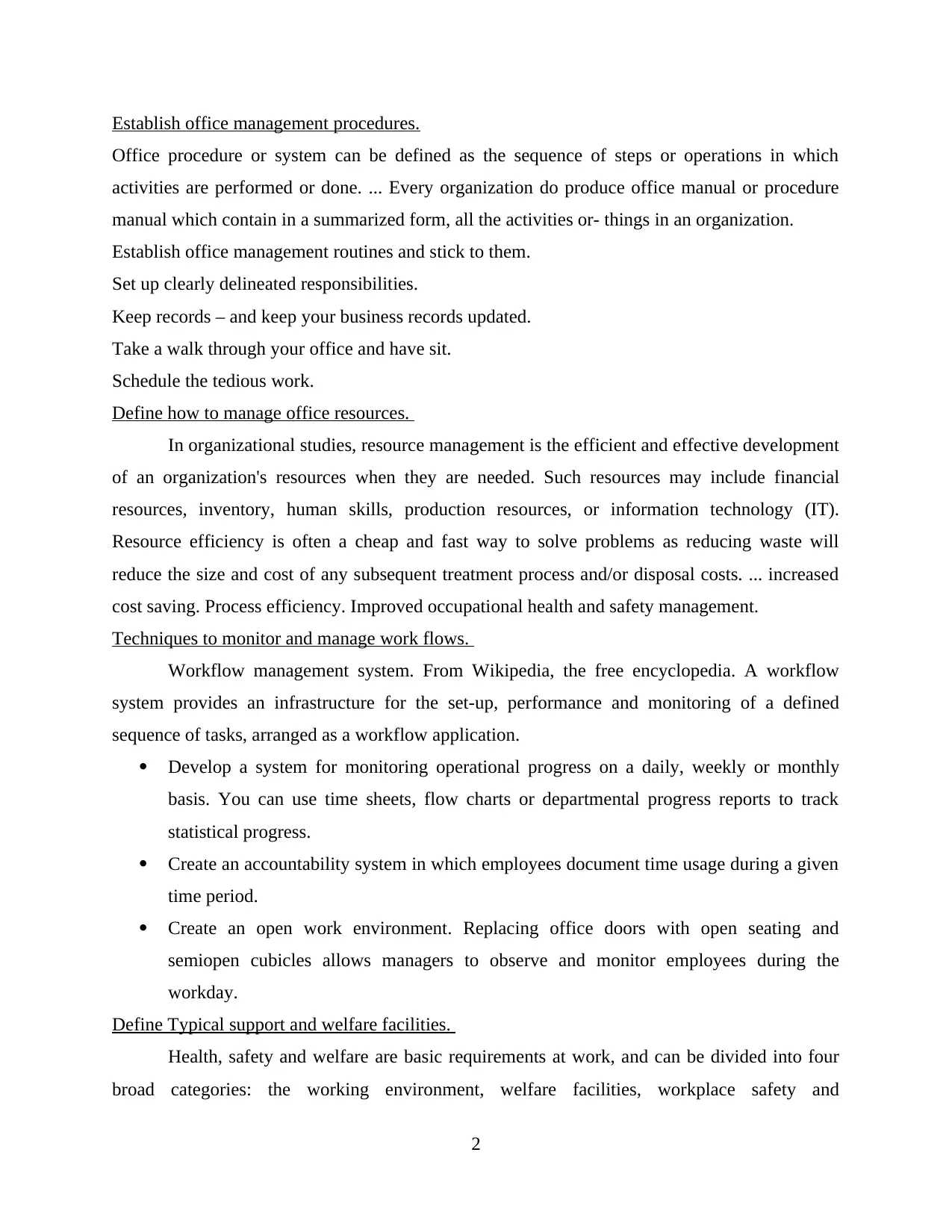
Establish office management procedures.
Office procedure or system can be defined as the sequence of steps or operations in which
activities are performed or done. ... Every organization do produce office manual or procedure
manual which contain in a summarized form, all the activities or- things in an organization.
Establish office management routines and stick to them.
Set up clearly delineated responsibilities.
Keep records – and keep your business records updated.
Take a walk through your office and have sit.
Schedule the tedious work.
Define how to manage office resources.
In organizational studies, resource management is the efficient and effective development
of an organization's resources when they are needed. Such resources may include financial
resources, inventory, human skills, production resources, or information technology (IT).
Resource efficiency is often a cheap and fast way to solve problems as reducing waste will
reduce the size and cost of any subsequent treatment process and/or disposal costs. ... increased
cost saving. Process efficiency. Improved occupational health and safety management.
Techniques to monitor and manage work flows.
Workflow management system. From Wikipedia, the free encyclopedia. A workflow
system provides an infrastructure for the set-up, performance and monitoring of a defined
sequence of tasks, arranged as a workflow application.
Develop a system for monitoring operational progress on a daily, weekly or monthly
basis. You can use time sheets, flow charts or departmental progress reports to track
statistical progress.
Create an accountability system in which employees document time usage during a given
time period.
Create an open work environment. Replacing office doors with open seating and
semiopen cubicles allows managers to observe and monitor employees during the
workday.
Define Typical support and welfare facilities.
Health, safety and welfare are basic requirements at work, and can be divided into four
broad categories: the working environment, welfare facilities, workplace safety and
2
Office procedure or system can be defined as the sequence of steps or operations in which
activities are performed or done. ... Every organization do produce office manual or procedure
manual which contain in a summarized form, all the activities or- things in an organization.
Establish office management routines and stick to them.
Set up clearly delineated responsibilities.
Keep records – and keep your business records updated.
Take a walk through your office and have sit.
Schedule the tedious work.
Define how to manage office resources.
In organizational studies, resource management is the efficient and effective development
of an organization's resources when they are needed. Such resources may include financial
resources, inventory, human skills, production resources, or information technology (IT).
Resource efficiency is often a cheap and fast way to solve problems as reducing waste will
reduce the size and cost of any subsequent treatment process and/or disposal costs. ... increased
cost saving. Process efficiency. Improved occupational health and safety management.
Techniques to monitor and manage work flows.
Workflow management system. From Wikipedia, the free encyclopedia. A workflow
system provides an infrastructure for the set-up, performance and monitoring of a defined
sequence of tasks, arranged as a workflow application.
Develop a system for monitoring operational progress on a daily, weekly or monthly
basis. You can use time sheets, flow charts or departmental progress reports to track
statistical progress.
Create an accountability system in which employees document time usage during a given
time period.
Create an open work environment. Replacing office doors with open seating and
semiopen cubicles allows managers to observe and monitor employees during the
workday.
Define Typical support and welfare facilities.
Health, safety and welfare are basic requirements at work, and can be divided into four
broad categories: the working environment, welfare facilities, workplace safety and
2
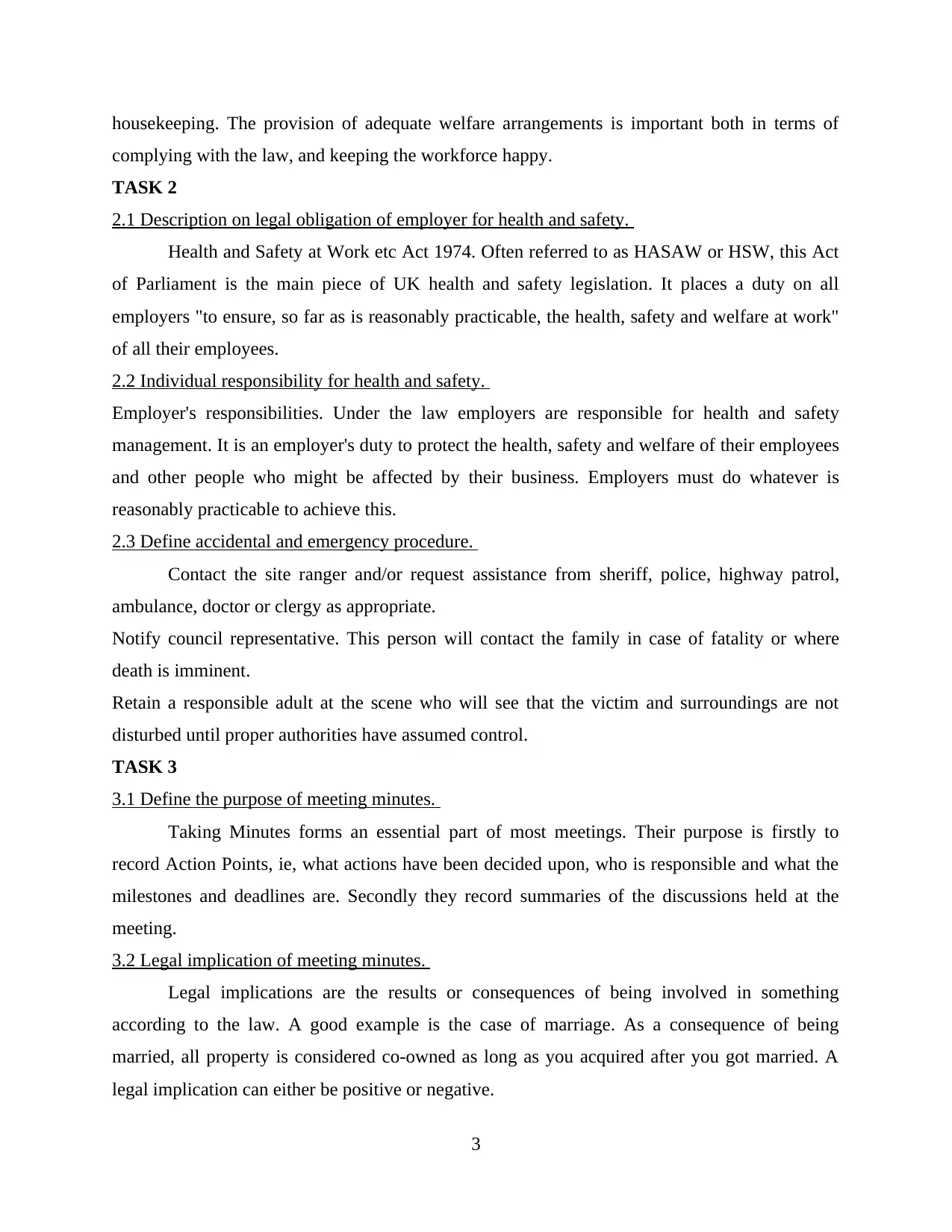
housekeeping. The provision of adequate welfare arrangements is important both in terms of
complying with the law, and keeping the workforce happy.
TASK 2
2.1 Description on legal obligation of employer for health and safety.
Health and Safety at Work etc Act 1974. Often referred to as HASAW or HSW, this Act
of Parliament is the main piece of UK health and safety legislation. It places a duty on all
employers "to ensure, so far as is reasonably practicable, the health, safety and welfare at work"
of all their employees.
2.2 Individual responsibility for health and safety.
Employer's responsibilities. Under the law employers are responsible for health and safety
management. It is an employer's duty to protect the health, safety and welfare of their employees
and other people who might be affected by their business. Employers must do whatever is
reasonably practicable to achieve this.
2.3 Define accidental and emergency procedure.
Contact the site ranger and/or request assistance from sheriff, police, highway patrol,
ambulance, doctor or clergy as appropriate.
Notify council representative. This person will contact the family in case of fatality or where
death is imminent.
Retain a responsible adult at the scene who will see that the victim and surroundings are not
disturbed until proper authorities have assumed control.
TASK 3
3.1 Define the purpose of meeting minutes.
Taking Minutes forms an essential part of most meetings. Their purpose is firstly to
record Action Points, ie, what actions have been decided upon, who is responsible and what the
milestones and deadlines are. Secondly they record summaries of the discussions held at the
meeting.
3.2 Legal implication of meeting minutes.
Legal implications are the results or consequences of being involved in something
according to the law. A good example is the case of marriage. As a consequence of being
married, all property is considered co-owned as long as you acquired after you got married. A
legal implication can either be positive or negative.
3
complying with the law, and keeping the workforce happy.
TASK 2
2.1 Description on legal obligation of employer for health and safety.
Health and Safety at Work etc Act 1974. Often referred to as HASAW or HSW, this Act
of Parliament is the main piece of UK health and safety legislation. It places a duty on all
employers "to ensure, so far as is reasonably practicable, the health, safety and welfare at work"
of all their employees.
2.2 Individual responsibility for health and safety.
Employer's responsibilities. Under the law employers are responsible for health and safety
management. It is an employer's duty to protect the health, safety and welfare of their employees
and other people who might be affected by their business. Employers must do whatever is
reasonably practicable to achieve this.
2.3 Define accidental and emergency procedure.
Contact the site ranger and/or request assistance from sheriff, police, highway patrol,
ambulance, doctor or clergy as appropriate.
Notify council representative. This person will contact the family in case of fatality or where
death is imminent.
Retain a responsible adult at the scene who will see that the victim and surroundings are not
disturbed until proper authorities have assumed control.
TASK 3
3.1 Define the purpose of meeting minutes.
Taking Minutes forms an essential part of most meetings. Their purpose is firstly to
record Action Points, ie, what actions have been decided upon, who is responsible and what the
milestones and deadlines are. Secondly they record summaries of the discussions held at the
meeting.
3.2 Legal implication of meeting minutes.
Legal implications are the results or consequences of being involved in something
according to the law. A good example is the case of marriage. As a consequence of being
married, all property is considered co-owned as long as you acquired after you got married. A
legal implication can either be positive or negative.
3
⊘ This is a preview!⊘
Do you want full access?
Subscribe today to unlock all pages.

Trusted by 1+ million students worldwide
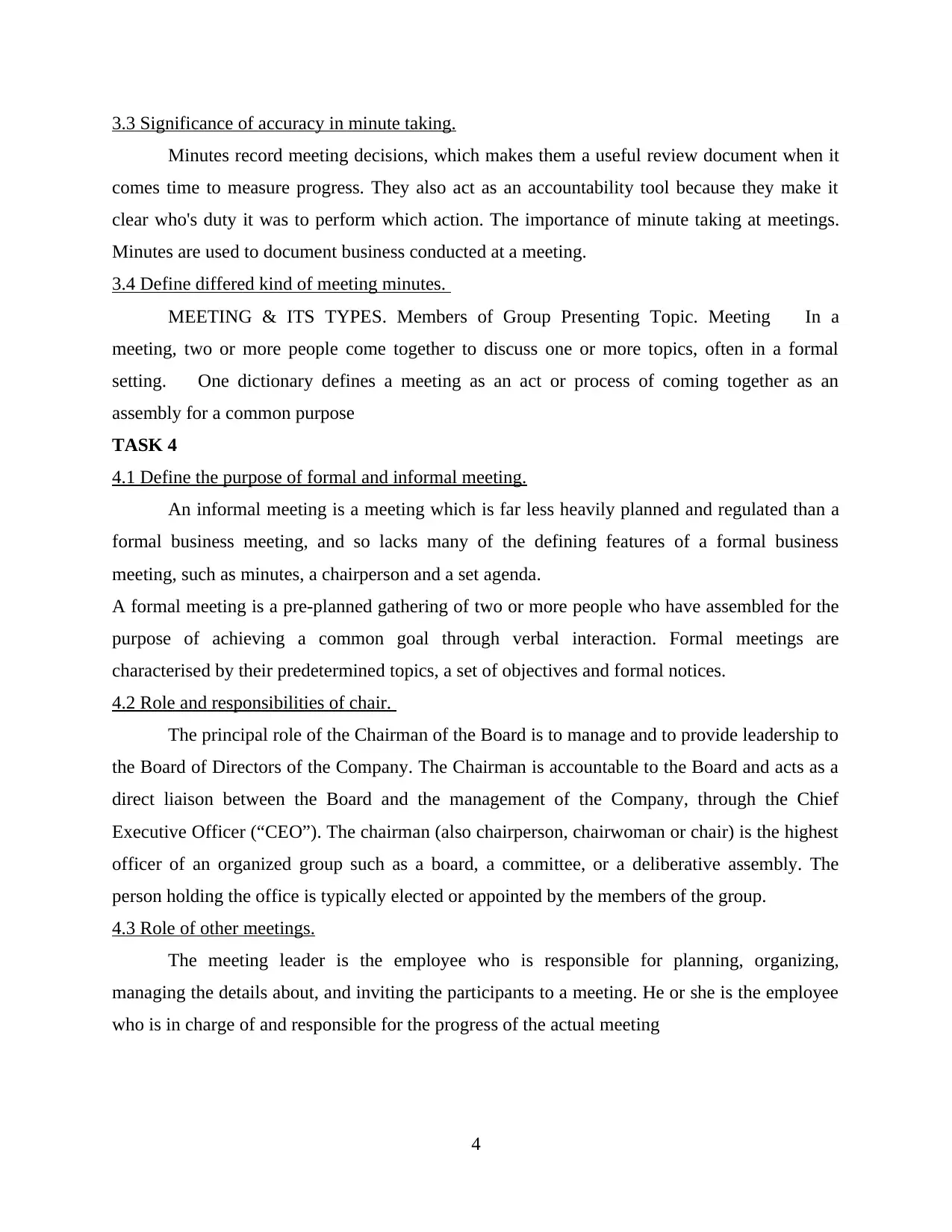
3.3 Significance of accuracy in minute taking.
Minutes record meeting decisions, which makes them a useful review document when it
comes time to measure progress. They also act as an accountability tool because they make it
clear who's duty it was to perform which action. The importance of minute taking at meetings.
Minutes are used to document business conducted at a meeting.
3.4 Define differed kind of meeting minutes.
MEETING & ITS TYPES. Members of Group Presenting Topic. Meeting In a
meeting, two or more people come together to discuss one or more topics, often in a formal
setting. One dictionary defines a meeting as an act or process of coming together as an
assembly for a common purpose
TASK 4
4.1 Define the purpose of formal and informal meeting.
An informal meeting is a meeting which is far less heavily planned and regulated than a
formal business meeting, and so lacks many of the defining features of a formal business
meeting, such as minutes, a chairperson and a set agenda.
A formal meeting is a pre-planned gathering of two or more people who have assembled for the
purpose of achieving a common goal through verbal interaction. Formal meetings are
characterised by their predetermined topics, a set of objectives and formal notices.
4.2 Role and responsibilities of chair.
The principal role of the Chairman of the Board is to manage and to provide leadership to
the Board of Directors of the Company. The Chairman is accountable to the Board and acts as a
direct liaison between the Board and the management of the Company, through the Chief
Executive Officer (“CEO”). The chairman (also chairperson, chairwoman or chair) is the highest
officer of an organized group such as a board, a committee, or a deliberative assembly. The
person holding the office is typically elected or appointed by the members of the group.
4.3 Role of other meetings.
The meeting leader is the employee who is responsible for planning, organizing,
managing the details about, and inviting the participants to a meeting. He or she is the employee
who is in charge of and responsible for the progress of the actual meeting
4
Minutes record meeting decisions, which makes them a useful review document when it
comes time to measure progress. They also act as an accountability tool because they make it
clear who's duty it was to perform which action. The importance of minute taking at meetings.
Minutes are used to document business conducted at a meeting.
3.4 Define differed kind of meeting minutes.
MEETING & ITS TYPES. Members of Group Presenting Topic. Meeting In a
meeting, two or more people come together to discuss one or more topics, often in a formal
setting. One dictionary defines a meeting as an act or process of coming together as an
assembly for a common purpose
TASK 4
4.1 Define the purpose of formal and informal meeting.
An informal meeting is a meeting which is far less heavily planned and regulated than a
formal business meeting, and so lacks many of the defining features of a formal business
meeting, such as minutes, a chairperson and a set agenda.
A formal meeting is a pre-planned gathering of two or more people who have assembled for the
purpose of achieving a common goal through verbal interaction. Formal meetings are
characterised by their predetermined topics, a set of objectives and formal notices.
4.2 Role and responsibilities of chair.
The principal role of the Chairman of the Board is to manage and to provide leadership to
the Board of Directors of the Company. The Chairman is accountable to the Board and acts as a
direct liaison between the Board and the management of the Company, through the Chief
Executive Officer (“CEO”). The chairman (also chairperson, chairwoman or chair) is the highest
officer of an organized group such as a board, a committee, or a deliberative assembly. The
person holding the office is typically elected or appointed by the members of the group.
4.3 Role of other meetings.
The meeting leader is the employee who is responsible for planning, organizing,
managing the details about, and inviting the participants to a meeting. He or she is the employee
who is in charge of and responsible for the progress of the actual meeting
4
Paraphrase This Document
Need a fresh take? Get an instant paraphrase of this document with our AI Paraphraser
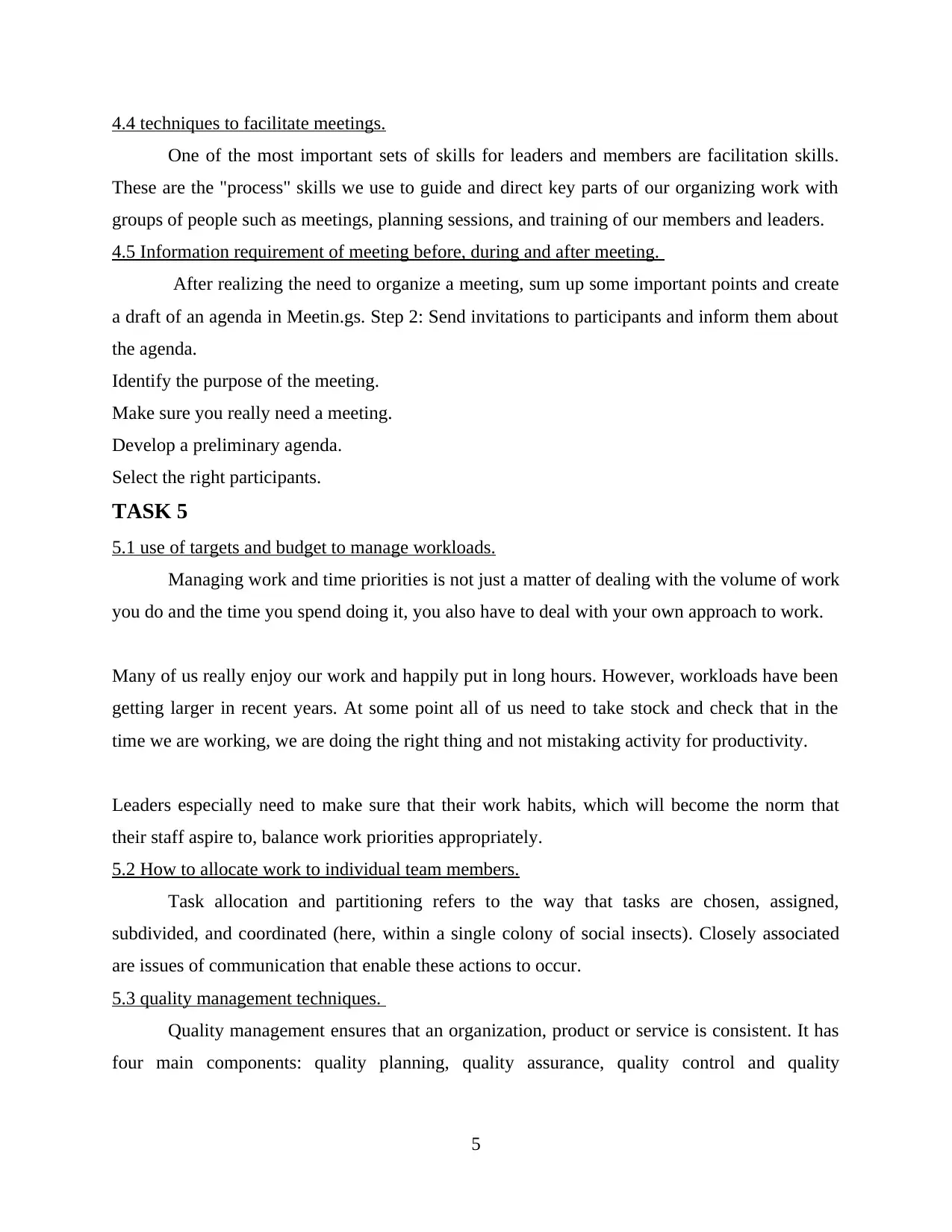
4.4 techniques to facilitate meetings.
One of the most important sets of skills for leaders and members are facilitation skills.
These are the "process" skills we use to guide and direct key parts of our organizing work with
groups of people such as meetings, planning sessions, and training of our members and leaders.
4.5 Information requirement of meeting before, during and after meeting.
After realizing the need to organize a meeting, sum up some important points and create
a draft of an agenda in Meetin.gs. Step 2: Send invitations to participants and inform them about
the agenda.
Identify the purpose of the meeting.
Make sure you really need a meeting.
Develop a preliminary agenda.
Select the right participants.
TASK 5
5.1 use of targets and budget to manage workloads.
Managing work and time priorities is not just a matter of dealing with the volume of work
you do and the time you spend doing it, you also have to deal with your own approach to work.
Many of us really enjoy our work and happily put in long hours. However, workloads have been
getting larger in recent years. At some point all of us need to take stock and check that in the
time we are working, we are doing the right thing and not mistaking activity for productivity.
Leaders especially need to make sure that their work habits, which will become the norm that
their staff aspire to, balance work priorities appropriately.
5.2 How to allocate work to individual team members.
Task allocation and partitioning refers to the way that tasks are chosen, assigned,
subdivided, and coordinated (here, within a single colony of social insects). Closely associated
are issues of communication that enable these actions to occur.
5.3 quality management techniques.
Quality management ensures that an organization, product or service is consistent. It has
four main components: quality planning, quality assurance, quality control and quality
5
One of the most important sets of skills for leaders and members are facilitation skills.
These are the "process" skills we use to guide and direct key parts of our organizing work with
groups of people such as meetings, planning sessions, and training of our members and leaders.
4.5 Information requirement of meeting before, during and after meeting.
After realizing the need to organize a meeting, sum up some important points and create
a draft of an agenda in Meetin.gs. Step 2: Send invitations to participants and inform them about
the agenda.
Identify the purpose of the meeting.
Make sure you really need a meeting.
Develop a preliminary agenda.
Select the right participants.
TASK 5
5.1 use of targets and budget to manage workloads.
Managing work and time priorities is not just a matter of dealing with the volume of work
you do and the time you spend doing it, you also have to deal with your own approach to work.
Many of us really enjoy our work and happily put in long hours. However, workloads have been
getting larger in recent years. At some point all of us need to take stock and check that in the
time we are working, we are doing the right thing and not mistaking activity for productivity.
Leaders especially need to make sure that their work habits, which will become the norm that
their staff aspire to, balance work priorities appropriately.
5.2 How to allocate work to individual team members.
Task allocation and partitioning refers to the way that tasks are chosen, assigned,
subdivided, and coordinated (here, within a single colony of social insects). Closely associated
are issues of communication that enable these actions to occur.
5.3 quality management techniques.
Quality management ensures that an organization, product or service is consistent. It has
four main components: quality planning, quality assurance, quality control and quality
5
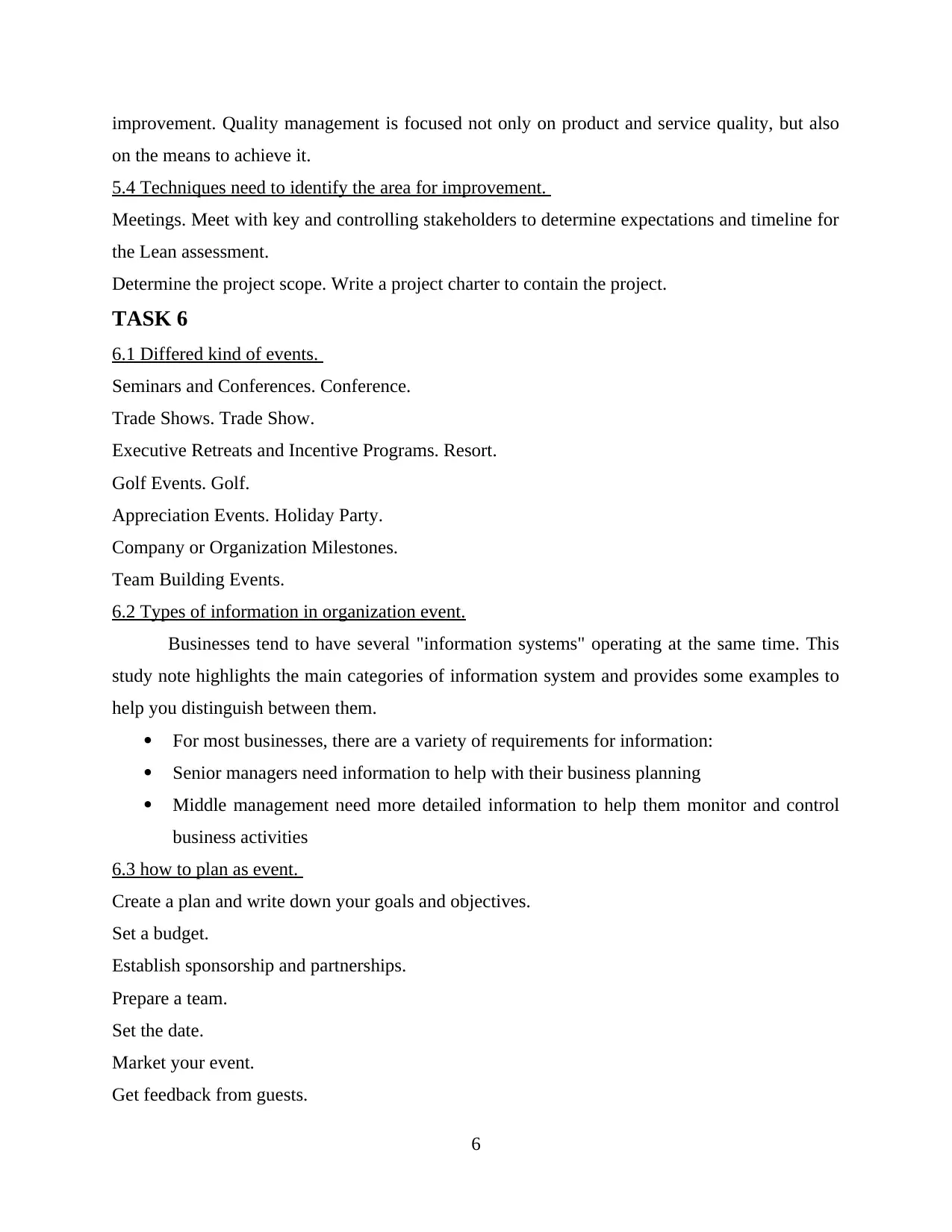
improvement. Quality management is focused not only on product and service quality, but also
on the means to achieve it.
5.4 Techniques need to identify the area for improvement.
Meetings. Meet with key and controlling stakeholders to determine expectations and timeline for
the Lean assessment.
Determine the project scope. Write a project charter to contain the project.
TASK 6
6.1 Differed kind of events.
Seminars and Conferences. Conference.
Trade Shows. Trade Show.
Executive Retreats and Incentive Programs. Resort.
Golf Events. Golf.
Appreciation Events. Holiday Party.
Company or Organization Milestones.
Team Building Events.
6.2 Types of information in organization event.
Businesses tend to have several "information systems" operating at the same time. This
study note highlights the main categories of information system and provides some examples to
help you distinguish between them.
For most businesses, there are a variety of requirements for information:
Senior managers need information to help with their business planning
Middle management need more detailed information to help them monitor and control
business activities
6.3 how to plan as event.
Create a plan and write down your goals and objectives.
Set a budget.
Establish sponsorship and partnerships.
Prepare a team.
Set the date.
Market your event.
Get feedback from guests.
6
on the means to achieve it.
5.4 Techniques need to identify the area for improvement.
Meetings. Meet with key and controlling stakeholders to determine expectations and timeline for
the Lean assessment.
Determine the project scope. Write a project charter to contain the project.
TASK 6
6.1 Differed kind of events.
Seminars and Conferences. Conference.
Trade Shows. Trade Show.
Executive Retreats and Incentive Programs. Resort.
Golf Events. Golf.
Appreciation Events. Holiday Party.
Company or Organization Milestones.
Team Building Events.
6.2 Types of information in organization event.
Businesses tend to have several "information systems" operating at the same time. This
study note highlights the main categories of information system and provides some examples to
help you distinguish between them.
For most businesses, there are a variety of requirements for information:
Senior managers need information to help with their business planning
Middle management need more detailed information to help them monitor and control
business activities
6.3 how to plan as event.
Create a plan and write down your goals and objectives.
Set a budget.
Establish sponsorship and partnerships.
Prepare a team.
Set the date.
Market your event.
Get feedback from guests.
6
⊘ This is a preview!⊘
Do you want full access?
Subscribe today to unlock all pages.

Trusted by 1+ million students worldwide
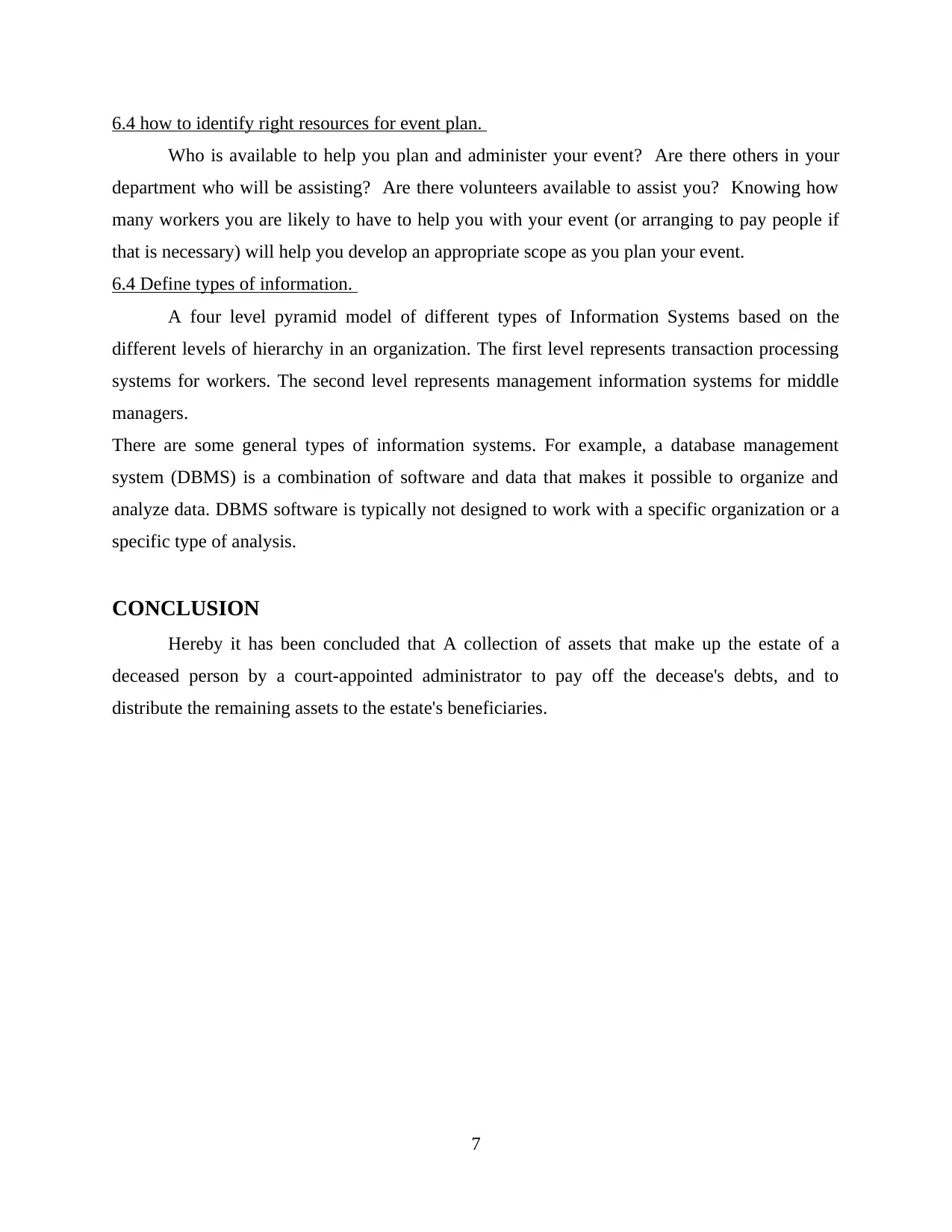
6.4 how to identify right resources for event plan.
Who is available to help you plan and administer your event? Are there others in your
department who will be assisting? Are there volunteers available to assist you? Knowing how
many workers you are likely to have to help you with your event (or arranging to pay people if
that is necessary) will help you develop an appropriate scope as you plan your event.
6.4 Define types of information.
A four level pyramid model of different types of Information Systems based on the
different levels of hierarchy in an organization. The first level represents transaction processing
systems for workers. The second level represents management information systems for middle
managers.
There are some general types of information systems. For example, a database management
system (DBMS) is a combination of software and data that makes it possible to organize and
analyze data. DBMS software is typically not designed to work with a specific organization or a
specific type of analysis.
CONCLUSION
Hereby it has been concluded that A collection of assets that make up the estate of a
deceased person by a court-appointed administrator to pay off the decease's debts, and to
distribute the remaining assets to the estate's beneficiaries.
7
Who is available to help you plan and administer your event? Are there others in your
department who will be assisting? Are there volunteers available to assist you? Knowing how
many workers you are likely to have to help you with your event (or arranging to pay people if
that is necessary) will help you develop an appropriate scope as you plan your event.
6.4 Define types of information.
A four level pyramid model of different types of Information Systems based on the
different levels of hierarchy in an organization. The first level represents transaction processing
systems for workers. The second level represents management information systems for middle
managers.
There are some general types of information systems. For example, a database management
system (DBMS) is a combination of software and data that makes it possible to organize and
analyze data. DBMS software is typically not designed to work with a specific organization or a
specific type of analysis.
CONCLUSION
Hereby it has been concluded that A collection of assets that make up the estate of a
deceased person by a court-appointed administrator to pay off the decease's debts, and to
distribute the remaining assets to the estate's beneficiaries.
7
Paraphrase This Document
Need a fresh take? Get an instant paraphrase of this document with our AI Paraphraser
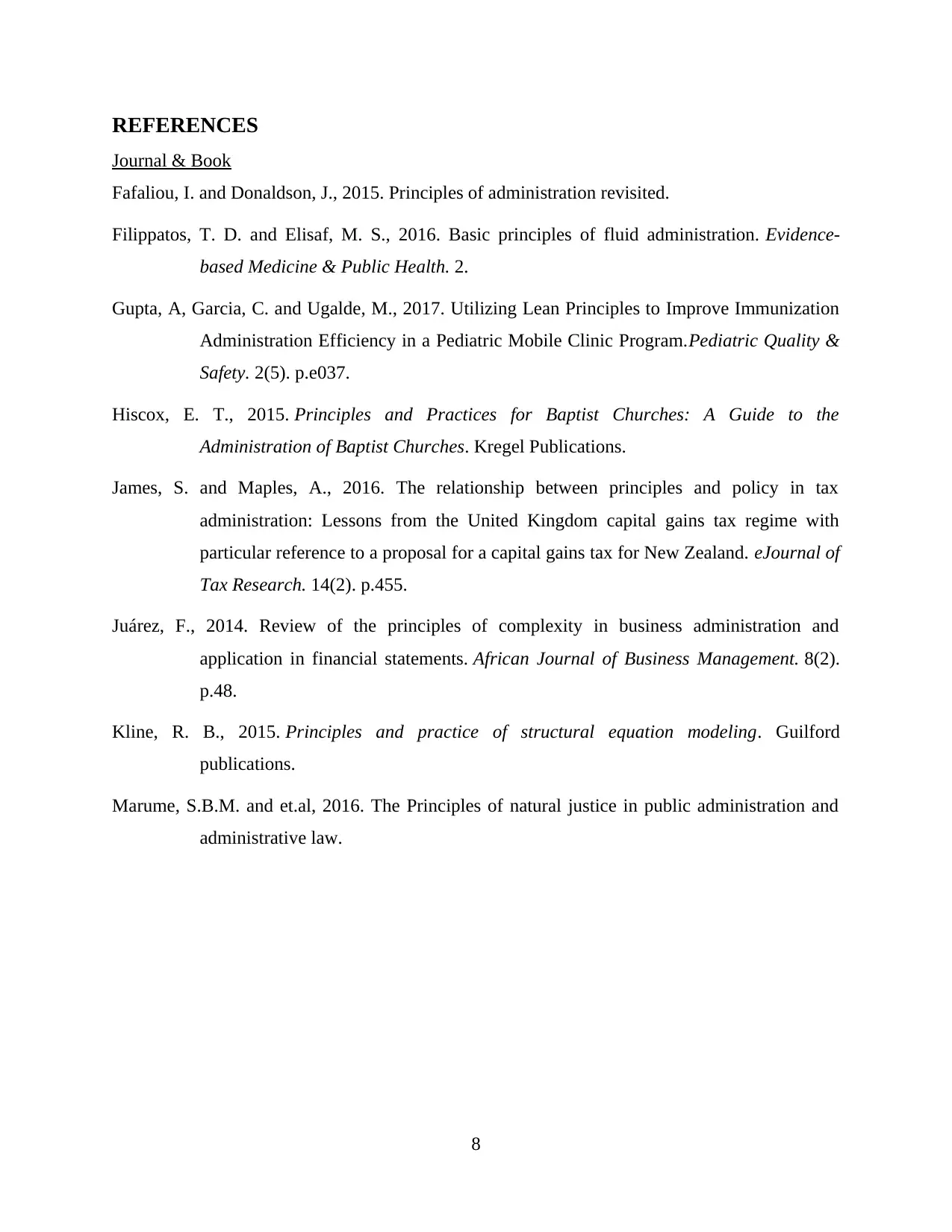
REFERENCES
Journal & Book
Fafaliou, I. and Donaldson, J., 2015. Principles of administration revisited.
Filippatos, T. D. and Elisaf, M. S., 2016. Basic principles of fluid administration. Evidence-
based Medicine & Public Health. 2.
Gupta, A, Garcia, C. and Ugalde, M., 2017. Utilizing Lean Principles to Improve Immunization
Administration Efficiency in a Pediatric Mobile Clinic Program.Pediatric Quality &
Safety. 2(5). p.e037.
Hiscox, E. T., 2015. Principles and Practices for Baptist Churches: A Guide to the
Administration of Baptist Churches. Kregel Publications.
James, S. and Maples, A., 2016. The relationship between principles and policy in tax
administration: Lessons from the United Kingdom capital gains tax regime with
particular reference to a proposal for a capital gains tax for New Zealand. eJournal of
Tax Research. 14(2). p.455.
Juárez, F., 2014. Review of the principles of complexity in business administration and
application in financial statements. African Journal of Business Management. 8(2).
p.48.
Kline, R. B., 2015. Principles and practice of structural equation modeling. Guilford
publications.
Marume, S.B.M. and et.al, 2016. The Principles of natural justice in public administration and
administrative law.
8
Journal & Book
Fafaliou, I. and Donaldson, J., 2015. Principles of administration revisited.
Filippatos, T. D. and Elisaf, M. S., 2016. Basic principles of fluid administration. Evidence-
based Medicine & Public Health. 2.
Gupta, A, Garcia, C. and Ugalde, M., 2017. Utilizing Lean Principles to Improve Immunization
Administration Efficiency in a Pediatric Mobile Clinic Program.Pediatric Quality &
Safety. 2(5). p.e037.
Hiscox, E. T., 2015. Principles and Practices for Baptist Churches: A Guide to the
Administration of Baptist Churches. Kregel Publications.
James, S. and Maples, A., 2016. The relationship between principles and policy in tax
administration: Lessons from the United Kingdom capital gains tax regime with
particular reference to a proposal for a capital gains tax for New Zealand. eJournal of
Tax Research. 14(2). p.455.
Juárez, F., 2014. Review of the principles of complexity in business administration and
application in financial statements. African Journal of Business Management. 8(2).
p.48.
Kline, R. B., 2015. Principles and practice of structural equation modeling. Guilford
publications.
Marume, S.B.M. and et.al, 2016. The Principles of natural justice in public administration and
administrative law.
8
1 out of 11
Related Documents
Your All-in-One AI-Powered Toolkit for Academic Success.
+13062052269
info@desklib.com
Available 24*7 on WhatsApp / Email
![[object Object]](/_next/static/media/star-bottom.7253800d.svg)
Unlock your academic potential
Copyright © 2020–2025 A2Z Services. All Rights Reserved. Developed and managed by ZUCOL.





